Occupational Therapy
What is a Sensory Gym?
Sensory gyms are structured environments fitted with specialized pieces of equipment proven to help children and adults with specialized equipment that is designed to stimulate a child’s senses, as well as their vestibular and proprioception systems. Sensory gym equipment improves body awareness, motor skills, as well as communication and social skills. A true sensory gym is designed to create a nurturing and inclusive environment for children of varying abilities.
Who would benefit from a sensory gym?
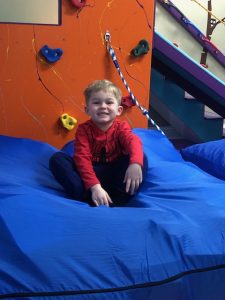 In our experience, while sensory gyms are an awesome way for ALL children to strengthen muscles, and improve communication and body awareness, they are especially beneficial for children with sensory processing disorders. Children with sensory processing disorders are either over-stimulated by stimuli in their environments (including sights and sounds) or under-stimulated and unable to process sensory input as effectively as other children. Sensory gyms allow children to have fun while building up their tolerance to activity and sensory input.
In our experience, while sensory gyms are an awesome way for ALL children to strengthen muscles, and improve communication and body awareness, they are especially beneficial for children with sensory processing disorders. Children with sensory processing disorders are either over-stimulated by stimuli in their environments (including sights and sounds) or under-stimulated and unable to process sensory input as effectively as other children. Sensory gyms allow children to have fun while building up their tolerance to activity and sensory input.
coordination, muscle strength, and motor planning.
Our Sensory Gyms
Our sensory gyms are amazing! The equipment in our sensory gyms was selected by our occupational and physical therapists. Each piece of equipment encourages play, helps build independence, improves motor development, and even assists in communication skills. Kids have fun playing while meeting their therapy goals, and they don’t even realize it’s work! What more could you ask for?
Here are some of the pieces of equipment we have in our sensory gyms and the benefits they can provide our children.
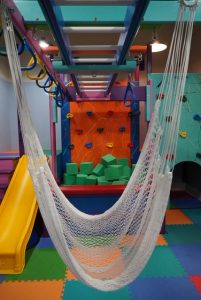 Swings:
Swings:
We have many different types of swings that can be used to build up the upper body and core strength, increase balance, and encourage body awareness and coordination. The movement of the swings provides input to the vestibular system which can be either alerting or calming, depending on the child. We have a platform, hammock, bolster, and regular seat swing!
Slides:
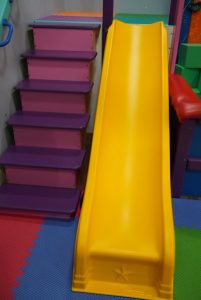 Like our swings, the slides are wonderful for providing vestibular input. Slides are great for improving full-body strength and coordination as well as upright posture and core strength. The stairs and ninja ramps leading to the slides are also used to help promote bilateral coordination, muscle strength, and motor planning.
Like our swings, the slides are wonderful for providing vestibular input. Slides are great for improving full-body strength and coordination as well as upright posture and core strength. The stairs and ninja ramps leading to the slides are also used to help promote bilateral coordination, muscle strength, and motor planning.
Zip Line:
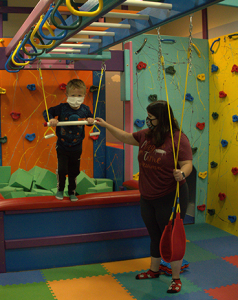 The zip lines are SO much fun for the children and therapists alike! They are a great way to build up muscle endurance, enhancing a child’s ability to integrate and tolerate movement while they challenge themselves to hold on long enough to make it to the other end. The zip line encourages vestibular input, upper body strength, fast movement, jumping, and tumbling.
The zip lines are SO much fun for the children and therapists alike! They are a great way to build up muscle endurance, enhancing a child’s ability to integrate and tolerate movement while they challenge themselves to hold on long enough to make it to the other end. The zip line encourages vestibular input, upper body strength, fast movement, jumping, and tumbling.
Rock Walls & Monkey Bars:
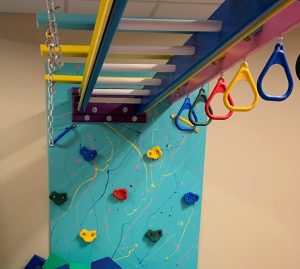 The rock walls and monkey bars promote full-body awareness, motor planning, and bilateral coordination. A child’s body weight combined with gravity provides important proprioceptive input for a child’s joints which, in turn, helps the child coordinate movements. The rock walls are also helpful for children overcoming the fear of climbing and heights.
The rock walls and monkey bars promote full-body awareness, motor planning, and bilateral coordination. A child’s body weight combined with gravity provides important proprioceptive input for a child’s joints which, in turn, helps the child coordinate movements. The rock walls are also helpful for children overcoming the fear of climbing and heights.
Tunnels:
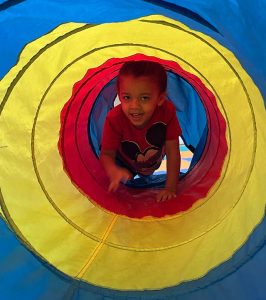 The tunnels provide a cozy hideout for a child. The resistance, enclosed space, and tactile input from crawling through the tunnel also encourage self-regulation and tactile exploration. When children get overstimulated by colors, noises, or too much activity, our tunnels are a great, darker, and quieter ‘hide-out’ for some calming sensory input. Our tunnels are all equipped with dry erase boards on the insides, so children can also practice writing and fine motor skills while taking a break in the tunnels.
The tunnels provide a cozy hideout for a child. The resistance, enclosed space, and tactile input from crawling through the tunnel also encourage self-regulation and tactile exploration. When children get overstimulated by colors, noises, or too much activity, our tunnels are a great, darker, and quieter ‘hide-out’ for some calming sensory input. Our tunnels are all equipped with dry erase boards on the insides, so children can also practice writing and fine motor skills while taking a break in the tunnels.
Crash Pads/Foam pits:
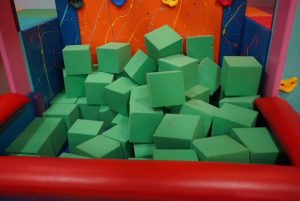 Who doesn’t love a foam pit or crash pad?!? These are perfect for children who are “sensory seekers” or who just like to practice their jumping skills. They encourage safe falling, deep pressure stimulation, and self-regulation. Children work on improving their balance, endurance, stamina, overall strength, and motor planning while jumping and crawling on the crash pads and in the foam pit.
Who doesn’t love a foam pit or crash pad?!? These are perfect for children who are “sensory seekers” or who just like to practice their jumping skills. They encourage safe falling, deep pressure stimulation, and self-regulation. Children work on improving their balance, endurance, stamina, overall strength, and motor planning while jumping and crawling on the crash pads and in the foam pit.
